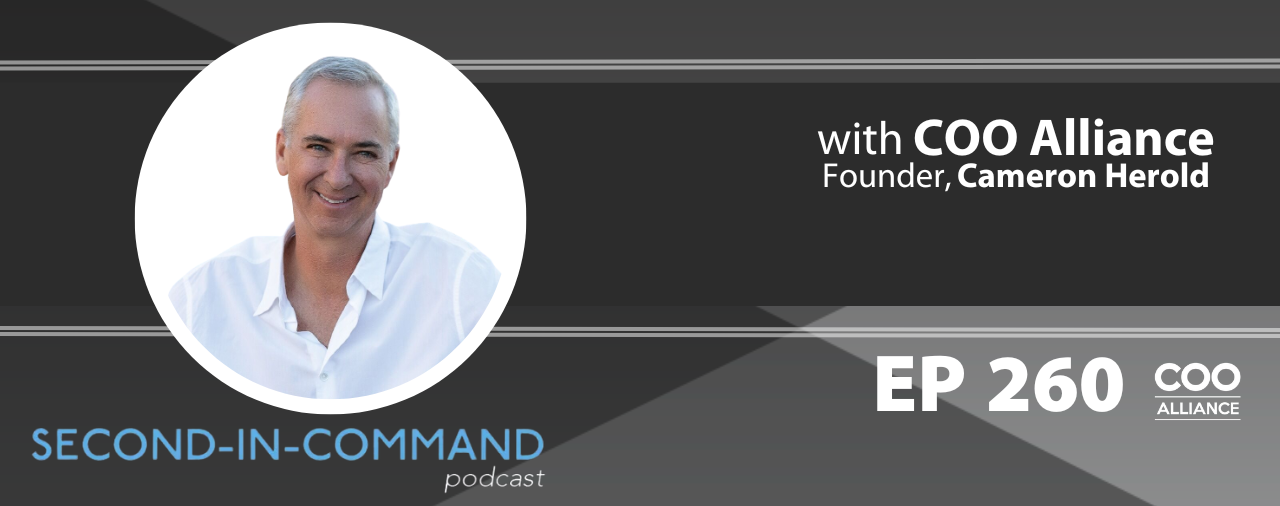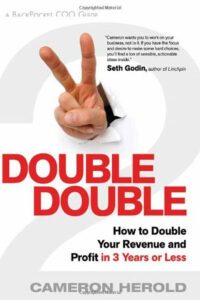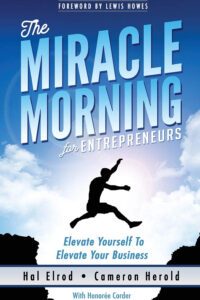Are you a CEO looking to take your business to the next level without burning out? In this episode, Cameron discusses his advice on growing your company without overworking yourself. Key to this is hiring the right personnel, starting with outsourcing to fractional employees before moving on to full-time hires, with an emphasis on revenue-producing roles. Cameron also recommends hiring ahead of the curve and using a “vivid vision” to attract potential hires. But how do you make the decision to hire full-time versus outsourcing? It all comes down to workload. Cameron also shares his personal experiences with burnout and hiring practices.
In This Episode You’ll Discover:
- Cameron’s advice on growing a business without overworking oneself.
- Hiring the right personnel is crucial, starting with outsourcing and fractional employees, and focusing on revenue-producing roles.
- Hiring ahead of the curve is recommended, and the vivid vision can be used to attract potential hires.
- The decision to hire full-time versus outsourcing should be based on workload, and Cameron shares personal experiences about burnout and hiring practices. Additionally, the interview covers diversity, virtual companies, and hiring practices, including the importance of aligning values and purpose in the workplace.
Resources:
Connect with Cameron: Website | LinkedIn
Get Cameron’s latest book “Second in Command: Unleash the Power of your COO”
Subscribe to our YouTube channel – Second in Command Podcast on YouTube
Get Cameron’s online course – Invest In Your Leaders
—
Are you getting burned out as a leader of your company? Are you frustrated trying to grow the business without destroying yourself? In this episode, you’re going to read my thoughts about both. We’re going to cover who to hire and when to hire them. I’ll tell you about times when I burned out and was clinically redlining with stress and how I got through it. I’m going to explain why you’re doing it all wrong and that you should be at the bottom of the org chart, not at the top. You’re going to love this episode.
—
If you’re a 1 or 2-man show, put your hand up. Keep them up if you work more than you’d like. For that amount of the room, they are working more than they want. They are 1 or 2-man shows. The biggest transition that I have seen, like the biggest challenge, has been for those individuals to get the first hire or to start learning how to build the team. There were several of our backroom members who were 1 and 2-man shows. There was a first one that was difficult, but after that, the team started to blossom. What have you seen be the process for hiring the right person? Who are the first hires that you think need to be in place in order to get that moving?
Even before the first hire, a lot of it is our stop-doing list or what I call my fuck-it list. You got to look at a lot of the stuff that’s on your list of stuff that you do day-to-day and decide what things you’re not going to do anymore because some of it is pointless. The next hire that I would get into is I start outsourcing using oDesks or Elance. I am looking for fractional people that I can hire who can do little bits of work instead of full-time employees.
The first full-time employee I’m probably going to get to is either going to be a sales or marketing person. It will probably be a salesperson or anyone who can drive revenue. In my world, revenue solves problems. There’s not a single problem that exists that can’t be solved by a check. The more gross margin you have coming in, the more people you can hire. I’d be looking for revenue-producing roles versus overhead and then hiring fractional people as much as I can.
Do you think that you should hire people that will grow into a role or people that should have already done it?
I ideally like to hire ahead of the curve. I hire people that I know I’m going to need in two years. I try to hire them early and tell them to roll up their sleeves and get dirty. It’s like, “I know this role is a little bit beneath you, but look where we’re going.” I use the vivid vision as a way to attract them. We’re passing out the bag to bring in the donations for leukemia and also the draw. The draws for the full package and the Double Double fast track that I filled out with you, which is all 4 of my speaking videos, 10 copies of my book, and 1 hour of my coaching time, you can also buy that package as well. I’ll also donate 10% of all the Double Double fast tracks to Leukemia as well. For the $1,297 package, I’ll donate $150 from every package to leukemia as well. That’s for anyone filling those out.
You were talking about hiring ahead of the curve. I want to know. Would you hire somebody who’s done it before or would they grow into that?
Yes. I’m hiring people who have done it before as much as possible, which is why I like outsourcing because I can get people that have done it. More often than not, we don’t need full-time employees. We need some stuff done, but we don’t need an employee. We need the stuff done. If you can get somebody who can do it three hours once a week, I’d rather have some fractional people or some part-time people than a full-time one.
What would you consider the difference? Meaning, for what role would you hire a full-time person? There are a lot of people in the room who are saying, “I have a lot of things that need to get done. How do identify which ones need to get outsourced and which ones need to be full-time people?”
You start grouping all your tasks together and all your projects together into buckets. You’ll start seeing that some of the buckets have a lot of stuff. As soon as you have enough stuff that is going to be getting done for a number of hours, you can say, “Now, it’s really a full-time role.” If you see that it is stuff and it is only a few hours a week, then you can outsource it. As soon as your stuff gets to maybe 30 or 40 hours, then you’re going to start hiring full-time people.
I asked you this question after we recorded the episode that I wish we had been recording. I’m going to ask you here on stage. You seem like you have it all together. Do you ever get stressed?
Yes. I get stressed all the time. Back in October 2000, I had an employee. We built a private currency company. Prior to Bitcoin, we created a currency called Ubarter.com. We had 30,000 companies accepting our currency instead of the US dollar. We sold the company to network commerce in January 2000 for $64 million.
When we were selling the company, the stock crashed. We were public and they were public. I went in to get a physical done because I’d gotten married and we were buying a house. I’d collapsed on the floor of the elevator crying a couple of days before with stress. The doctor said, “Is everything okay?” I said, “Yes. Everything’s good. I need to get this physical so I can get insurance.” He goes, “Is there anything wrong with your body?” I’m like, “No. Everything’s good.”
I said, “I’ve got this weird metallic taste in the back of my neck. It’s almost like I’m chewing on aluminum foil.” Has anybody ever had that aluminum foil or tin foil taste? Put your hand up if you’ve had it. Put your hand up high if you’ve had that aluminum foil taste. It’s a chemical secretion that is caused by stress. I don’t remember the name of the stress test, but I had 9 of the 10 most stressful events happening simultaneously.
My mom was diagnosed with cancer. We bought a house. I’d quit my job. The stock market had collapsed. I’d lost $30 million. I had gained some weight. I was drinking a lot. I was moving from Seattle back to Canada. I thought everything was good. I thought I had my shit together, but my body was telling me that I was stressed. This chemical secretion was me clinically redlining.
I get stressed. I’ve lost 35 pounds since then. I run a lot. I do meditation. I do the Morning S.A.V.E.R.S. from Miracle Morning. I’m in way better shape than I was ever in. All of this money is going to be donated to leukemia. Evan was part of the COO Alliance, which is the only network of the kind in the world for second in commands. I’m going to have Evan take care of getting this to leukemia. He can also get a count done and tell us how much we raised. That would be great.
We’ll get it done. I want to go into stress. Has anybody ever felt stressed? As entrepreneurs, especially those of us who are leading companies, we put a tremendous amount of pressure on ourselves. I honestly don’t know what to do about that except to become incredibly present with what your own personal needs are and make sure that you’re not siphoning those as a way of sacrificing for the business. That’s because then, you burn out. You’ve worked with a bunch of entrepreneurs and have experienced this yourself. How do you coach somebody through particularly stressful times?
I wrote about it in Double Double. Chapter twelve is The Highs and Lows of CEOs. We go through this rollercoaster of emotions that are magnified because we’re the ones who have our house on the line and we’re recruiting people to join our great company even though we’re not sure we’re going to be in business in two weeks.
We have this magnification of stress. We can’t tell our board and our employees what’s going on. We’re often living in this very scary place. The stress that we’re under is magnified. When you’re at what I call the crisis of meaning, which is that real death spiral at the bottom where you’re stressed, depressed, or you’re at home calling your employee saying, “I can’t come in this afternoon. I’m busy,” and you’ve got the duvet pulled up over your head, you need to detach. You need to take a vacation.
In fact, I said to Evan, “I want Ryan to make sure he takes 2 or 3 days after the event is over to go on vacation with no laptop and no cell phone.” You need to decompress because as soon as this event is over, and you know it, you’re going to crash. I want you to take a vacation for a few days. Promise me that you’ll detach. Will you do that?
You bet.
You have to do that. Stop working at night. You’re not going to get it all done. You’re lying to yourself. You’re avoiding your relationships. You’re avoiding pain in some way. You’re avoiding the fact that you’ve lost hobbies. Stop it. You’re not going to get it all done. As soon as you catch up, you’re going to have a new list anyway. Work a solid day and then have a solid afternoon, evening, and weekend of fun. Get some hobbies back in your life. Get some grounding back in and be interested in stuff.
I go to the main TED conference every year. I’m going to TED Global over in Africa. I go on vacations. My wife and I are going to sail in the British Virgin Islands with a Hollywood director and his girlfriend for a week after Christmas. We are going skiing with my kids before Christmas. I’ll take ten weeks of vacation every year when I have no phone.
This wasn’t always the case.
I’ve had to learn this. Even in a startup, if I was in a two-person startup, I would never work nights again and would never work weekends again. You have to get balance. You’re not going to get it all done. You’re operating on this reduced capacity. You think you’re working hard. You think you’re getting stuff done, but you’re not.
I’ve got a client who only sells on Amazon. His company is called Viva Labs or Viva Naturals. They are Husayn’s products. If you look up coconut oil on Amazon, he’s got the number one product on Amazon with 16,000 to 17,000 reviews. He’s gone from $3 million to $38 million in three years that I’ve coached him. Husayn is working out with a personal trainer, never working weekends, and never working evenings. He is spending time with his kids and going to the park. It’s hard for him to unlearn these habits, but he’s realizing it’s powerful.
There are a lot of individuals who are at that $3 million point. What did you coach that client through to get go from $3 million to $38 million?
The first one was to look for very profitable products and sell more of those. Find all the high gross margin products because revenue solves problems. The next one was to get focused. He had a million things that he wanted to be working on. It was about starting to pick the critical few. If you think about building a home for a second and you want to put the wolf stove and the cool cabinets, we’ll get there. Let’s get the foundation locked and loaded first, and then let’s get the walls, plumbing, and electrical.
For him, it was the vivid vision, core values, core purpose, and BHAG. It was getting rid of some bad employees, hiring some good employees, putting interviewing and hiring systems in place, engaging with some executive search firms that recruit for him, driving PR, driving marketing, and driving culture. We then grew it from there.
What do you think are the responsibilities of the person leading the company or the founder of the company?
The CEO or the entrepreneur is about vision. You’re the one who has to be the caretaker of vision and culture. I always say the entrepreneur can only have around five direct reports because you also have your board, legal, and culture that you have to take care of. The CEO’s job is around growing people. I flip the org chart upside down. The CEOs at the bottom of the org chart are supporting the VPs who support the managers who support the employees who support the customers. It’s an inverted pyramid, your org chart. If you do it right, your job is to be able to support. My job is to direct you, make sure you’re working on the right stuff, and give you the emotional support and technical support you might need through mentoring or situational leadership to help you.
I could sit here and talk to Cameron all day about this, but I love the fact that we’re getting into really tactical stuff. We’re going to reserve time for four questions if you want to grab one. What have you seen be the traits in entrepreneurs who make that pivot from a single million-dollar business to growing? You’ve made that transition multiple times and worked with people who have made that transition. Most entrepreneurs never grow beyond that, so what have you seen be the traits in those who make that?
The first time I’ve ever put it in writing is in the last chapter of The Miracle Morning for Entrepreneurs, but I’ll give it to you here. It’s three things. It’s focus, faith, and effort. Write down these numbers for a second. Put down F times F times E. What percent focused are you? How focused are you on the critical few things? How focused are you on a channel or on your products? How focused are you during the day? Are you wasting time on Facebook and stuff? What percent-focused are you out of 1% to 100%? How much faith do you have? What percent faith do you have in your business, your economy, and the market? How comfortable do you feel with it all? What percent on a scale of 1% to 100%? How much effort are you and your team putting in? Are you guys working hard or hardly working?
Let’s say that you had 50% focus times 50% faith times 50% effort. That comes out to a 12.5% chance of success. If you’re even at 80% focus times 80% faith times 80% effort, that’s only a 51% chance of success. You may as well go to Vegas and put it all in red. To truly be successful, even 90% focus, 90% faith, and 90% effort is only a 74% chance of success.
What I’ve seen the most successful entrepreneurs do, and I’ve coached some of the best in the world, is it is about focus, faith, and effort. They work on the critical few things with the best employees. They work on protecting their confidence. They work on relaxing. It’s those basic things. Business is so simple. If you go back to your office and teach everybody how to run meetings, it will help your company in a huge way. If you don’t, you’ll spend the rest of your life saying business is difficult.
You reiterated that you need to handcuff your best employees. You said you need to find out what they need to be handcuffed with. Why don’t we ask them straight up what they want?
We should. That’s exactly what you do. You say, “What would keep you here? You know that you’re a great employee. I know you’re a great employee. I want you here forever. What would keep you here?” I have an executive assistant, Meredith Kuba, who is fantastic. She is finishing her first year with me. My old one was with me for four years. I asked her, “What would keep you?” She goes, “I’m never leaving.” I said, “That’s not my question. What would keep you here?” You have to ask.
You talked about firing quickly. Do you tend to prepare to fire? For people you’re telling to fire people on Monday at noon, are you thinking that they should have a replacement in mind?
The cost of keeping the wrong person is fifteen times their salary. Let me give you a couple of reasons why you need to fire them even before you have the replacement. Let’s say you have an A player. It is a really fantastic employee who comes in and says, “I’m quitting. I’m leaving because I can’t work with Bob anymore.” You go, “I’m firing him,” and then they are like, “I’ve already taken another job.” How would that feel?
Maybe you have a customer who leaves because of Bob. It may be you have the negativity or Bob makes a mistake. You have to make the cut. The test I work with entrepreneurs all the time is you got a phone and you found out Bob was hit by a car and killed, what would you do to replace him? Go back to the office, fire Bob, and start working on that list of five things. Get it done quickly and then do it with integrity and empathy.
I’ve heard all the time, “Legal, we can’t do it.” I sat in the CEO of Sprint’s office, Marcelo Claure. We top-graded his entire team. He called in his chief legal counsel. I won’t give you the title, but it was a guy who’d been with him for 27 years in a C-level role. He said, “I’m firing him tomorrow. Don’t tell me I can’t do it. Tell me what I need to do to do it because it’s happening tomorrow.” I sat with Governor Doug Ducey in Arizona. He fired the head of the Department of Transportation because he didn’t support Uber.
We can do whatever the hell we want. It might cost us 6 months’ severance, but that’s better than 15 times what it’s costing us to keep them. Our A players are your racehorses. Your B players are your workhorses. Your C players have to go to the glue factory. We give too much time to our bad players instead of to our As.
We’ve made difficult decisions learning how to hire. I’m also learning how to fire. I’ve also found that there’s fear going into it, but afterward, there’s so much freed-up energy in the office because everybody knew it was coming. When that happens, everybody rallies. There’s a new level of expectation.
It’s like a team playing shorthanded. I don’t know if you watch hockey. I love hockey. If you see a hockey team who’s down a player and they score a goal, it’s because they rally and work harder together. Seth Godin gave me the title Double Double. It was originally going to be called How to Get More Shit Done With Less People Faster. It’s because you don’t need these big, complex teams. You need the right people doing the right stuff and acting like Navy SEALS. If everybody is aligned, then life gets easy.

Business Growth: Your business doesn’t need big and complex teams. You need the right people doing the right stuff acting like Navy SEALs. If everybody is aligned, life gets easy.
When hiring for culture, you’re at risk of having a business full of White guys. I’m assuming you don’t. Tell us how you do that.
I’m not saying look for the same people as me. I’m saying I want people who line up culturally. They love the vivid vision, so they’re vibrating. They live the core values. That’s critical. That’s what I’m looking for.
I know that’s what you’re looking for, but how do you teach other people? There’s a difference.
It’s 2016. I’m quoting our Canadian Prime Minister when they said, “Why is your cabinet 50% women and 50% men?” It’s 20-fucking-16.
Silicon Valley is not listening.
I don’t work with them. I work with people who wake up in the morning and realize that women are as smart as men and African-Americans are as smart as Chinese. Can we please move past this discussion? For the most part, most people treat people like people. This isn’t a criticism of you. I went to TED Women. I was 1 of 20 guys in a room of 800 women at TED Women. Women were saying, “Let’s move past the discussion. We’re already there. We need to stop these old discussions and realize that most companies are already in diversity. Most places are already there. Let’s get rid of the people that aren’t.” Most of us are doing it. I’m in Vancouver, Canada. We have 52% Asian. The nickname for Vancouver is Hongcouver. My kids don’t notice the difference between them and Chinese kids because they are all the same. We’re way past the diversity discussion for the most part.
Let’s do one more.
This is a great talk. I was wondering. What would you suggest to someone who’s building a virtual company with five employees or less for culture?
I coach a group called Acceleration Partners. They do affiliate programs for all major brands like Uber. Any brand that you can think of, they’re running all their affiliate programs. They have 80 employees that are 100% virtual. All of our communication is on video, which is huge. When you use Zoom and you can communicate face-to-face with people, that’s massive. When you get your people together for quarterly meetings and retreats, hang out in breather spaces or Airbnbs, and communicate and work together, that’s huge.
The big-game changer is Facebook Workplace. That’s launching. We saw the beta of it. It’s like, “Holy shit.” It’s a private Facebook that is your company. It’s all of the tools and features of normal Facebook, but it’s for company use. There is Facebook Live streaming, groups, and chats. Slack is in a lot of trouble. Those kinds of tools are huge. It is also hiring people who get their stuff done. Deliver what you promise, respect the individual, and have pride in all you do. When you have that collaborative workforce distributed, those are core value things. They’re huge. It’s the video, getting together, and using the technology.
How would you reinforce it? You could tell them to read the vision statement. They read it and then a month later, it is hard to keep.
You hire people who already live them and fire people who don’t. I was asked by Fortune magazine in 2003, the first time I was interviewed by Fortune, “How do you motivate your employees?” I said, “I don’t motivate employees. I hire motivated people.” They asked Herb Kelleher from Southwest Airlines, “How do you get all your employees to smile?” He said, “I hire happy people who smile.” You can’t take grumpy people and make them smile. I can’t take people who aren’t aligned and align them. I can’t take people who don’t live core values and live them. I can’t take people who aren’t going to live the behavioral traits I’m looking for and create them. You interview better and hire better.

Business Growth: Hire people who already live your vision and mission statement. Fire those who do not.
I had a CEO. I had to check hard on this one. He said, “It takes about 90 days after you hire someone to know if they’re the right fit.” I said, “That’s because you have a shitty interview process. If you do it properly, you know the day you hire them if they’re the right person because you’ve grilled them so many ways. You’ve used a thread of reference checks. I can teach you some systems or have my books teach you systems so that you know before they even hire if they’re going to knock the cover off the ball.”
Thank you. This is the final question for you. A mutual friend of ours, Hal Elrod, was diagnosed. I’m curious. When you get news like that, it has a way of revealing what’s really important. For us drivers who are always thinking about work and success, that’s the biggest wake-up call ever. I’m curious. When you receive news like that, what immediately comes into focus as to what’s important?
My kids, my wife, myself, people, and the community. I went to Burning Man for the first time in 2007. I’ve been five times. That fundamentally changed me because I realized that you can’t judge a book by its cover anymore. I was meeting these incredible people who you don’t know what they do. No one talked about work. We spend a week together talking about our fears, our insecurities, our joys, and our passions.
I asked Evan a question. Let’s ask those questions. Let’s have real discussions with people. None of us are getting out of this alive. Every single one of us is going to die. Every single one of us is in pain. Every single one of us is a thirteen-year-old trapped inside an adult body. Let’s connect as our thirteen-year-olds again and love each other, hug each other, and work hard together. That’s what’s important.
The beauty of this is that it is the way that you make your dream happen. If you have a vision in your brain or a business that you want to build, get it on paper and get the right people in place. That was the model right there. Cameron, thank you so much for hanging out with us.
Thank you.
Important Links







